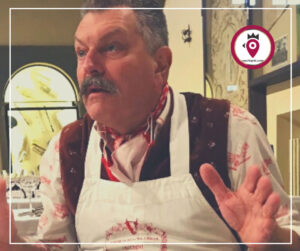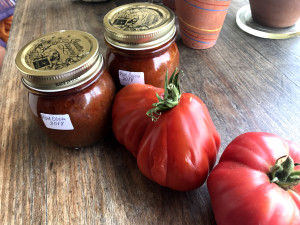Articolo disponibile anche in: Italian
It is a symbol of hospitality par excellence, the wine that has always toasted special occasions in Tuscany.
Vinsanto del Chianti Classico is perhaps the truest expression of traditional Chianti winemaking, with its generous baggage of stories, rituals and charm.
The spectacular sight of grapes laid out in the special drying rooms, the small oak barrels that accompany the wine along its ageing process, the aromas and hues that glow in the glass after years of expectation, all speak of a truly unique and special product.
These snapshots describe a precious nectar whose memory has faded over time in a sort of limbo between legend and reality. Starting with the origin of its name.
While the first official record of vinsanto can definitely be dated back to 1773, in the Villafranchi treaty of Tuscan Winemaking, there are various etymological explanations surrounding the origins of the name “Vinsanto”: from the vinification period which was, according to some, at the beginning of November, on All Saints Day, and according to others much later, in Holy Week (when, as some sources claim, the wine should be bottled).
Then, of course, there are the links to the clergy, because the wine was used during Mass. Another surviving legend claims that a Sienese monk who performed healing miracles during the plague of 1348 gave the afflicted this special wine to drink.
But the quirkiest version attributes the name to a linguistic misunderstanding in 1439 during the Council of Florence, when the word “Xantos” (“yellow” in Greek) pronounced by Bessarion (a patriarch of the Eastern Church) became “Santo” to Florentine ears, denoting the dried grape wine known at that time (and later) as “vin pretto” (pure wine).
It’s hard to say where the truth actually lies. What is certain is that – contrary to what one might think, seduced by the rural charm this wine evokes – its diffusion is due to the vices of rich noblemen who made and drank it as far back as the Middle Ages, because it was an exclusive product requiring an extremely laborious production process. This complex identity also characterises Vinsanto del Chianti Classico: noble in origin but the object of increasing popular approval.
Vinsanto del Chianti Classico is still a niche product awaiting discovery. It is produced in very limited quantities: less than 100,000 litres per year.
This may be due to the problems and risks of such laborious production requirements, as well as the marketing difficulties that surround all great wines with evolved aromas. But it could also be interpreted as a certain attitude of closure to outsiders, a prickliness typical of Chianti that strives to protect something felt to be strictly local, familiar even, from contamination.
The production specifications for “Vin Santo del Chianti Classico” DOC, implemented in 1995, bind Vinsanto to very strict quality standards, which had to some extent become even more selective in recent years.
The production regulations include the predominant use of Trebbiano and Malvasia grapes (minimum 60%) among the approved varieties (but the Occhio di Pernice – partridge eye – type also exists, so-called for its dark, intense colour, which is made with a minimum of 80% Sangiovese); low grape yields in the vineyards and very low grape-wine yields; time restrictions for vinification and sales (no earlier than three years from the grape harvest year), but also capacity limits for the ageing casks locally called caratelli (maximum 3hl, and must be oak).
However these rules are not the whole story: in factual terms the product expresses outstanding personality, which varies from estate to estate and from year to year.
We can take as read that it will be served with the dish of Sienese cakes, main Florentine sweets or the usual Prato cantuccini biscuits, but some Vinsanto del Chianti Classico can be served with certain mature Pecorino cheeses that would put the most full-bodied local red wines through their paces; sipped at a lower temperatures as an aperitif; others might be served as sipping wines at other times of day.
So this highly versatile product still has plenty to reveal.
On Vinsanto del Chianti Classico
- DANIELE CERNILLI
In recent years Vinsanto, especially the version made in Chianti Classico, the ancient birthplace of this wine, is becoming something more than a simple curiosity. Many estates are offering wines with huge organoleptic value, little gems comparable to what sherry is to Spain. A couple of decades ago, Giacomo Tachis dedicated a whole book to VinSanto, in the hope that it would become less ‘folkloric’ and technically better made. It seems to me that many producers have responded to his appeal and are now offering prestigious and technically masterful wines”.
- MASSIMO ZANICHELLI
“I have always been connected to VinSanto del Chianti Classico. It initiated me into learning about the world of wine. I still remember my first Vinitaly and the surprise and consequent excitement I felt when I tasted a 1989 ViNSanto: I would never have expected to experience those vivid sensations of dried fruit (figs, walnuts, sultanas) in a glass, nor to reawaken, like Proustian madeleine, the world of barns and attics that I had known since my childhood in the countryside. This wine of tradition, memory, hospitality still represents something unusual and extraordinary today; a wine that originates and develops in attic rooms, undergoing repeated oxidation, first with drying and then with fermentation and maturation in sealed caratelli. A wine that causes the most technical winemaking practice to throw up its hands in surrender, trusting to good luck and the spontaneity of the most positive changes; a wine that challenges the rules of contemporary winemaking, which seeks darkness and constant temperatures in underground rooms with reductive vinification, against the marked temperature changes and continual oxidative variations of attic spaces; a wine that challenges time, because it is capable of lasting longer than any other of its kind (even in an opened bottle). A wine that has made history, that represents a world apart (to be defended, protected, relaunched), a wine that is everyone’s heritage”.


